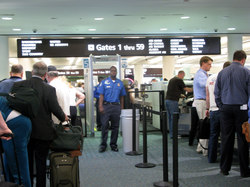
How long you will have to wait in lines at the airport this holiday season is a mystery, but some things are being done to speed up the lines.
One of them is automated lanes, commonly used in Europe, Canada and elsewhere, have just opened at American and United checkpoints at Chicago’s O’Hare International Airport and are in the works at other big hubs such as Newark, Los Angeles, Phoenix and Dallas-Fort Worth. They have multiple places for travelers to load trays for X-ray screening, so one slow passenger doesn’t delay everyone. If a suspicious item is detected, bins are automatically diverted to secondary screening instead of stopping the X-ray belt and waiting for an officer. Early tests in Atlanta show a 20% to 30% boost in items going through the scanner.
TSA is also optimistic about continued enrollment in PreCheck, where trusted travelers can leave liquids and laptops in bags and go through metal detectors with shoes on. The speedier screening helps shorten lines for travelers who haven’t enrolled in the program, which costs $85 for five years if you sign up through TSA or $100 for five years if you enroll in Customs and Border Protection Global Entry, which also speeds up time crossing into the U.S. at the border.
TSA now has about four million people enrolled in PreCheck. Another six million have access through other government trusted-traveler programs. Still, 10 million is below TSA’s original goal of 25 million. Applications peaked at 19,000 a day in June and now average about 6,000 a day. Airlines and credit-card companies have offered enrollment deals, such as using miles to cover the fee. TSA plans more advertising this fall.
The goal now is to get 50% to 60% of the daily traveling population in PreCheck. TSA is now at only 25% to 30% now. Some people who fall into certain categories—travel the same route repeatedly and don’t fall into high-risk groups based on past travel, for example—get PreCheck even though they haven’t signed up. However, if you want PreCheck every time, you better sign up.
One of them is automated lanes, commonly used in Europe, Canada and elsewhere, have just opened at American and United checkpoints at Chicago’s O’Hare International Airport and are in the works at other big hubs such as Newark, Los Angeles, Phoenix and Dallas-Fort Worth. They have multiple places for travelers to load trays for X-ray screening, so one slow passenger doesn’t delay everyone. If a suspicious item is detected, bins are automatically diverted to secondary screening instead of stopping the X-ray belt and waiting for an officer. Early tests in Atlanta show a 20% to 30% boost in items going through the scanner.
TSA is also optimistic about continued enrollment in PreCheck, where trusted travelers can leave liquids and laptops in bags and go through metal detectors with shoes on. The speedier screening helps shorten lines for travelers who haven’t enrolled in the program, which costs $85 for five years if you sign up through TSA or $100 for five years if you enroll in Customs and Border Protection Global Entry, which also speeds up time crossing into the U.S. at the border.
TSA now has about four million people enrolled in PreCheck. Another six million have access through other government trusted-traveler programs. Still, 10 million is below TSA’s original goal of 25 million. Applications peaked at 19,000 a day in June and now average about 6,000 a day. Airlines and credit-card companies have offered enrollment deals, such as using miles to cover the fee. TSA plans more advertising this fall.
The goal now is to get 50% to 60% of the daily traveling population in PreCheck. TSA is now at only 25% to 30% now. Some people who fall into certain categories—travel the same route repeatedly and don’t fall into high-risk groups based on past travel, for example—get PreCheck even though they haven’t signed up. However, if you want PreCheck every time, you better sign up.